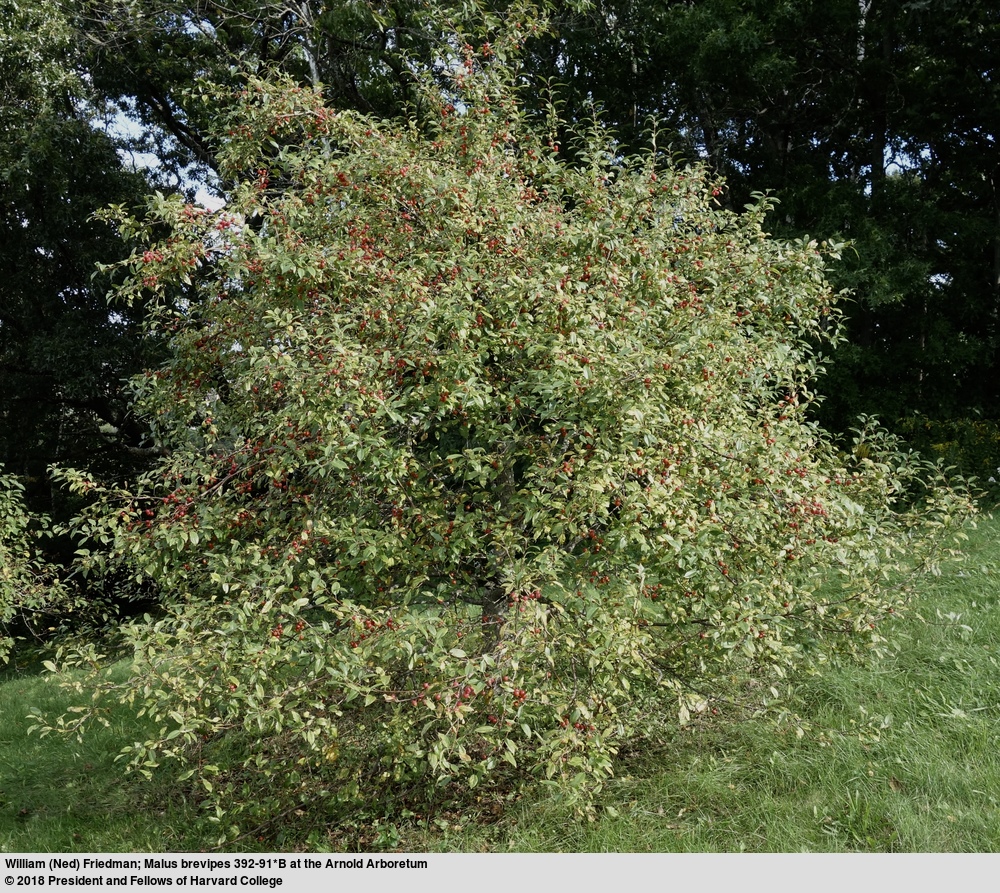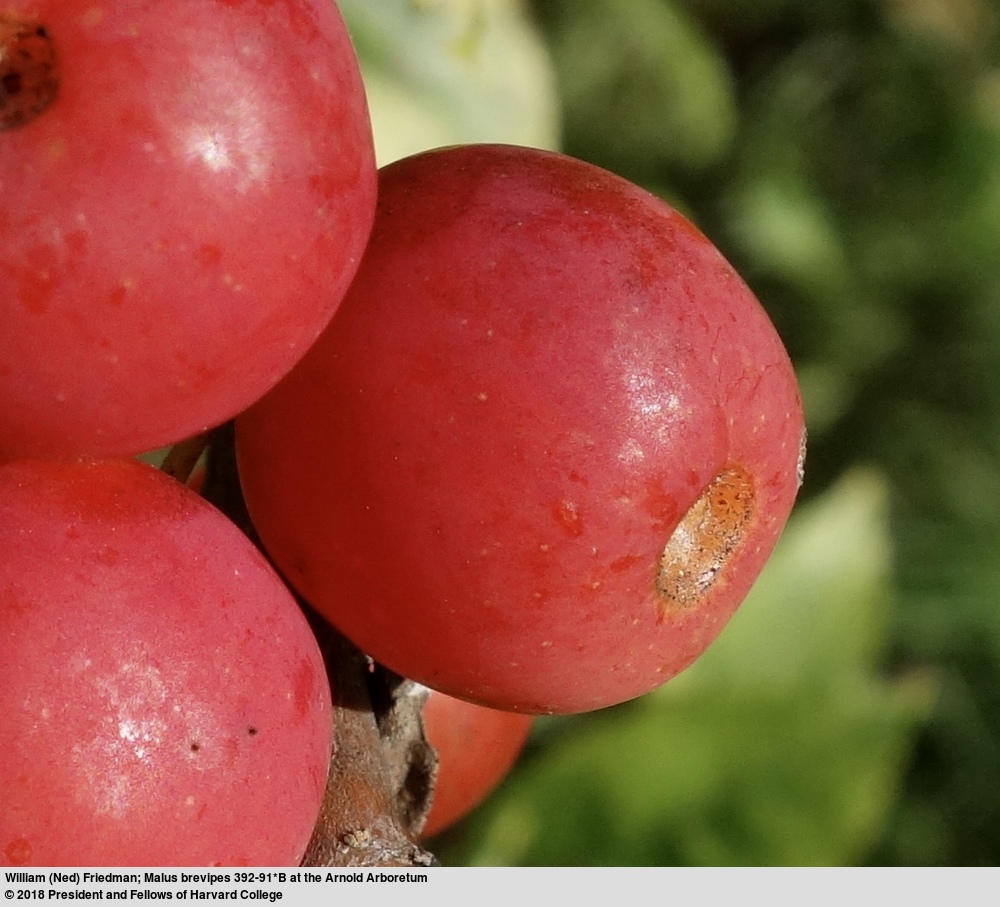Malus × brevipes
Sponsor
Kindly sponsored by
Francine: 'after many informative Tours and Study Days with the IDS I feel it only fitting to help and promote such a wonderful organisation'
Credits
Julian Sutton (species), Nick Dunn (cultivars) (2021)
Recommended citation
Sutton, J. & Dunn, N. (2021), 'Malus × brevipes' from the website Trees and Shrubs Online (treesandshrubsonline.
Genus
Synonyms
- Malus floribunda var. brevipes Rehd.
- Malus brevipes (Rehd.) Rehd.
Other taxa in genus
- Malus × adstringens
- Malus angustifolia
- Malus × arnoldiana
- Malus asiatica
- Malus × astracanica
- Malus × atrosanguinea
- Malus baccata
- Malus bhutanica
- Malus chitralensis
- Malus coronaria
- Malus crescimannoi
- Malus Cultivars A-B
- Malus Cultivars C
- Malus Cultivars D-F
- Malus Cultivars G-I
- Malus Cultivars J-K
- Malus Cultivars L-M
- Malus Cultivars N-Q
- Malus Cultivars R
- Malus Cultivars S
- Malus Cultivars T-Z
- Malus dasyphylla
- Malus × dawsoniana
- Malus domestica
- Malus doumeri
- Malus florentina
- Malus × floribunda
- Malus fusca
- Malus × gloriosa
- Malus halliana
- Malus × hartwigii
- Malus × heterophylla
- Malus honanensis
- Malus hupehensis
- Malus ioensis
- Malus kansuensis
- Malus kirghisorum
- Malus komarovii
- Malus × magdeburgensis
- Malus × micromalus
- Malus × moerlandsii
- Malus montana
- Malus ombrophila
- Malus orientalis
- Malus × platycarpa
- Malus praecox
- Malus prattii
- Malus prunifolia
- Malus × purpurea
- Malus × robusta
- Malus rockii
- Malus Rootstock Cultivars
- Malus Rosybloom Cultivars
- Malus × scheideckeri
- Malus sieversii
- Malus sikkimensis
- Malus × soulardii
- Malus spectabilis
- Malus spontanea
- Malus × sublobata
- Malus sylvestris
- Malus toringo
- Malus transitoria
- Malus trilobata
- Malus tschonoskii
- Malus turkmenorum
- Malus yunnanensis
- Malus × zumi
Very like the well-known Japanese Flowering Crab Malus × floribunda, probably also a hybrid. Malus × brevipes differs from M. × floribunda in that it has a shorter, denser and somewhat stiffer habit. The leaves are smaller with more closely serrate margins, and are never lobed. The flowers are smaller and somewhat paler. The fruits are bright red, subglobose, 1.5 cm diameter, slightly ribbed and borne in profusion on upright pedicels. (Fiala 1994; Grimshaw & Bayton 2009; Rehder 1920).
USDA Hardiness Zone 4-8
RHS Hardiness Rating H6
Malus brevipes is a familiar name in horticulture, but the status of most plants propagated under this name is less clear. We treat it here as a hybrid, Malus × brevipes. Rehder’s treatment of this plant, first as a botanical variety, then as a full species (Rehder 1920, 1926) seems with hindsight to have been a mistake. It was described from a single tree at the Arnold Arboretum grown from seed (presumably cultivated) labelled Pyrus sieboldii received ‘probably’ (Rehder 1920) from the Imperial Botanic Garden, St Petersburg in 1883 (Arnold Arboretum 2020; Rehder 1920). Vegetatively propagated specimens are still grown at the Arnold, the oldest from 1901 (33 cm basal diameter, 2015 – Arnold Arboretum 2020). It is completely unknown as a wild plant, and is to all intents and purposes a cultivar; we cannot be sure whether more than one clone exists in North America under this name.
Vegetatively propagated plants are offered in the UK nursery trade as M. brevipes and as M. brevipes ‘Wedding Bouquet’, but are rarely seen in commerce elsewhere. We have been unable to establish the circumstances of introduction(s) to Britain, although the large amounts of material passing between Kew and the Arnold in the years following the First World War suggest this as a likely route. It is not possible to say whether it crossed the Atlantic as vegetative material or seed; nor can we say whether or not British and American stocks look identical – they have probably never been grown together. It is not even clear whether ‘Wedding Bouquet’, by far the most widely grown of these plants and an excellent ornamental tree (described under ‘Cultivars T-Z’) is identical to all other British ‘brevipes’. However, there is circumstantial evidence that ‘Wedding Bouquet’ is not simply clonally propagated M. × brevipes under a new name: it was grafted from an old tree at Batsford Arboretum which shows no evidence of itself being a graft; while records are incomplete, Matthew Hall thinks it most likely to have been a seedling given perhaps by Kew (M. Hall pers. comm. 2020).
All this leaves M. × brevipes as no more than a horticulturally insignificant old hybrid cultivar, and the concept should be left to sink into obscurity.


